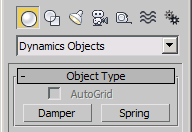Damper : GeometryClass
| Value > MAXWrapper > Node > GeometryClass > Damper |
Set binding method for damper:
0- Reference Objects (Choose this option when binding the damper to two objects.)
1- Free Spring (Choose this when using the damper as a simple object that's not bound to others or used in a dynamics simulation.)
The distance between the bottom center of the base and the top center of the piston when the damper is not bound.
Turn on/off renderability of the damper:
Turn on/off mapping coordinates for the object:
The diameter of the base, or "mount" of the damper.
The diameter of the main housing of the damper.
The height of the main housing.
The number of sides of both the base and the main housing.
The size of the fillet on the lower edge of the main housing.
The number of segments for Fillet 1. The higher this setting, the rounder the fillet profile appears.
The size of the fillet on the upper edge of the main housing.
The number of segments for Fillet 2. The higher this setting, the rounder the fillet profile appears.
The inside diameter of the main housing, which is actually a tube rather than a cylinder.
Turn on/off smoothing for the base and the main housing:
The number of sides in the piston.
Turn on/off smoothing for the piston:
Turn this on to add the boot to the damper:
The boot is an optional component of the damper that's similar to the rubber "accordion" boot found on various types of dampers, such as shock absorbers. The boot acts like a bound dynamic object, in that one of its ends is bound to the main housing, while the other is bound to the piston. Thus, as the piston moves within the housing, the boot expands and contracts to follow.
The minimum diameter of the boot. This and the next parameter affect the depth of the accordion folds in the boot.
The maximum diameter of the boot.
The number of sides making up the boot.
The number of accordion folds (bulges) along the height of the boot.
The number of segments in each fold.
The diameter of the stop, which is the ring at the top of the boot.
The thickness (height) of the stop ring.
The distance of the stop ring from the top of the piston.
The size of the fillet on the upper edge of the stop ring.
The number of segments the stop fillet. The higher this setting, the round the fillet profile appears.
Turn on/off smoothing for the boot:
Select which object is dynamic:
0- Damper (Select this option to use the damper object as a damper rather than an actuator.)
1- Actuator (Choose this when using the damper object as an Actuator.)
The force per unit linear speed.
Set the directional operation of the damper:
0- Compression Only (The damper reacts only to compression forces.)
1- Extension Only (The damper reacts only to expansion forces.)
2- Both (The damper reacts to both compression and expansion forces.)
The amount of force exerted between the two bound objects. Positive values push the objects apart, while negative values pull them together.


